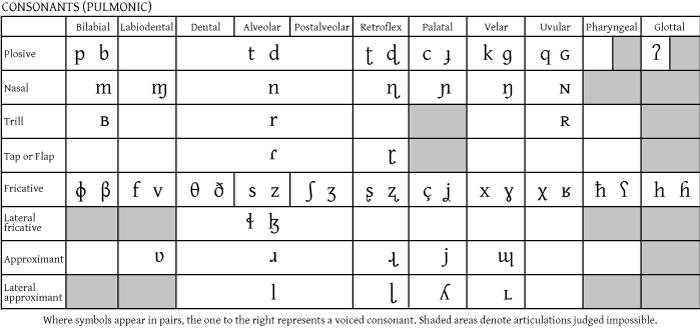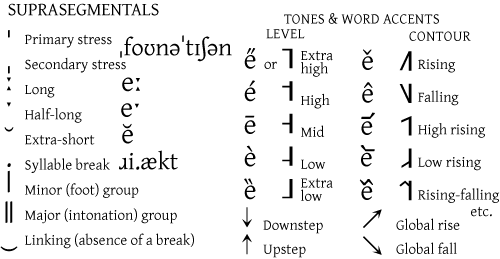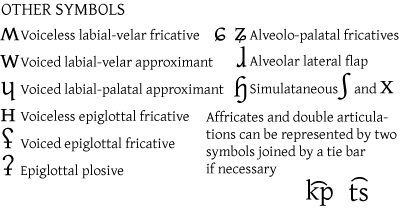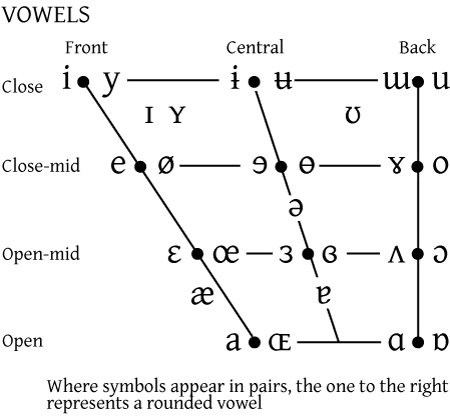International Phonetic Alphabet
|
|
Template:Redirect This article is about the alphabet officially used in linguistics. The NATO phonetic alphabet ("alpha bravo") had also informally been called the 'International Phonetic Alphabet', though these two are unrelated. See also IPA in Unicode and IPA for English.
The International Phonetic Alphabet is a system of phonetic notation used by linguists to accurately and uniquely represent each of the wide variety of sounds (phones or phonemes) the human vocal apparatus can produce. It is intended as a notational standard for the phonemic and phonetic representation of all languages.
For a simplified chart of the main IPA symbols used for English see IPA chart for English.
| Contents |
History
It was originally developed by French and British language teachers (led by Paul Passy) under the auspices of the International Phonetic Association, established in Paris in 1886 (both the organisation and the phonetic script are best known as IPA). The first official version of the alphabet appears in Passy (1888). These teachers based the IPA upon the Romic alphabet of Henry Sweet (1880–1881, 1971), which was formed from the Phonotypic Alphabet of Isaac Pitman and Alexander John Ellis (Kelly 1981).
The alphabet has undergone a number of revisions during its history, including some major ones codified by the IPA Kiel Convention (1989); the most recent revision was in 1993, updated again in 1996. The extIPA was first created in 1991, revised to 1997; the VoQS (Voice Quality Symbols) was proposed in 1995 to provide a system for more detailed transcription of voice production (Ball and others 1995).
Description
The IPA is primarily a phonemic alphabet, what MacMahon (1996) has termed a "selective" phonetic alphabet. The IPA aims to provide a symbolization of every constrastive sound occuring in human language. This means that the IPA is not primarily concerned with non-contrastive sounds. For instance, a flap and a tap are two different articulations, but since no language has (yet) been found to make a phonemic distinction between these two sounds the IPA does not provide a unique alphabetic letter (or diacritic) and instead provides a symbol (i.e. [ɾ]) that will cover both of these articulations. As a result, there does exist some ambiguity in IPA usage. However, it is important to note that in actual practice the IPA is used as true phonetic alphabet, especially through the use of diacritics.
The symbols chosen for the IPA are generally drawn from the Latin and Greek alphabets. The IPA has also created new symbols that are often modified versions of Latin letters.
The sound-values of the consonants that are identical to those in the Latin alphabet in most cases correspond to usage in English as well as many other European languages: , , , , , , , , , , , , , , .
The vowel symbols that are identical to those in the Latin alphabet (, , , , ) correspond roughly to the vowels of Spanish or Italian. is like the vowel in piece, like the vowel in food, etc.
Most of the other symbols that are shared with the Latin alphabet, like , , , and , correspond to sounds those letters represent in other languages. has the sound value of English y in yoke (= German, Scandinavian or Dutch j); whereas has the ancient Greek, Scandinavian, and Old English value of the letter (= Finnish y, German y or ü, French u, or Dutch uu.) The general principle is to use one symbol for one speech segment, avoiding letter combinations such as sh and th in English orthography.
Latin letters that share a particular modification often correspond to similar sound. For example, all the retroflex consonants have the same symbol as the equivalent alveolar consonants, except with a rightward pointing hook coming out of the bottom. Although there is an amount of correspondence between modified letters, generally the IPA does not have a systematic relationship between graphic shape and articulation. For instance, there is not a consistent relationship between lowercase letters and their small capital counterparts nor are all labiodental consonants linked through a common character design.
Diacritic marks can be combined with IPA signs to transcribe slightly modified phonetic values or secondary articulations. There are also special symbols for suprasegmental features such as stress and tone.
The International Phonetic Association recommends that a phonetic transcription should be enclosed in square brackets ("[" and "]"). A transcription that only denotes phonological contrasts (a "broad transcription") may be enclosed in slashes ("/"). For example some dialects of the English word pretzel in a phonetic (or "narrow") transcription would be , which notes several phonetic features that are not contrasted phonologically. An equivalent phonological (or "broad") transcription could be or even .
Chart
A text approximation of this chart with links to articles on the individual sounds is available at IPA in Unicode.

Download the IPA chart in PDF 1024x768 PNG of the entire chart
Comparison to other phonetic notation
The IPA is not the only phonetic transcription system in use. There are extended versions of the IPA, for example Luciano Canepari's canIPA.
There also exist somewhat similar alphabets in use by linguists working on Native American languages, Indic languages, Finno-Ugric languages, Caucasian languages and Slavic languages. The difference between these alphabets and IPA is relatively small, although often the special characters of the IPA are abandoned in favour of diacritics or digraphs in these alphabets, since many typewriters and older computer software have no support for the many special characters of the IPA.
Examples types of notation include iconic notation, such as the Visible Speech system created by Alexander Melville Bell (Ellis 1869:15), and analphabetic phonetic notation, such as the two systems created by Otto Jespersen (1889) and Kenneth Pike (1943).
See also
- International Phonetic Alphabet for English explains those IPA symbols used to represent the phonemes of English.
- IPA chart for English: simplifed version.
- IPA in Unicode
- List of phonetics topics
- TIPA provides IPA support for LaTeX.
- SAMPA, X-SAMPA and Kirshenbaum are other methods of mapping IPA designations into ASCII. IPA is preferred in Wikipedia articles, however.
- Unicode and HTML/IPA Extensions
External links
- Official home page of the IPA (http://www2.arts.gla.ac.uk/IPA/ipa.html)
- Peter Ladefoged's Course in Phonetics (with sound files) (http://hctv.humnet.ucla.edu/departments/linguistics/VowelsandConsonants/index.html)
- Pronounceable IPA chart (http://hctv.humnet.ucla.edu/departments/linguistics/VowelsandConsonants/course/chapter1/chapter1.html)
- IPA Lab (http://web.uvic.ca/ling/resources/ipa/ipa-lab.htm) Chart with sound files at University of Victoria.
- IPA chart source (http://www2.arts.gla.ac.uk/IPA/fullchart.html)
- IPA Chart (http://www.linguiste.org/phonetics/ipa/chart/) in Unicode and XHTML/CSS
- Interactive symbol selector (http://www.linguiste.org/phonetics/ipa/chart/keyboard/)
- WikiTeX (http://wikisophia.org/wiki/Wikitex#Tipa) supports editing IPA sequences directly in Wiki articles.
- Free Unicode phonetics font (http://scripts.sil.org/cms/scripts/page.php?site_id=nrsi&item_id=DoulosSILfont) (substitute for Times Roman, includes IPA characters)
- Extended versions of the IPA :
- canIPA (http://venus.unive.it/canipa/) : presents Luciano Canepari's system (500 base symbols, 300 complementary and 200 supplementary) and gives examples of its use for several major languages ; PDF documents excerpts of the books listed in References.
References
- Albright, Robert W. (1958). The International Phonetic Alphabet: Its background and development. International journal of American linguistics (Vol. 24, No. 1, Part 3); Indiana University research center in anthropology, folklore, and linguistics, publ. 7. Baltimore. (Doctoral dissertation, Standford University, 1953).
- Ball, Martin J.; Esling, John H.; & Dickson, B. Craig. (1995). The VoQS system for the transcription of voice quality. Journal of the International Phonetic Alphabet, 25 (2), 71-80.
- Canepari, Luciano. (2005a). "A Handbook of Phonetics: Natural Phonetics." München: Lincom Europa, pp. 518. ISBN 3-8958-480-3 (https://ssl.kundenserver.de/s83009615.einsundeinsshop.de/sess/utn1541a7584d7471b/shopdata/0002_New+titles/product_details.shopscript) (hb).
- Canepari, Luciano. (2005b) "A Handbook of Pronunciation: English, Italian, French, German, Spanish, Portuguese, Russian, Arabic, Hindi, Chinese, Japanese, Esperanto." München: Lincom Europa, pp. 436. ISBN 3-89586-481-1 (https://ssl.kundenserver.de/s83009615.einsundeinsshop.de/sess/utn1541a7584d7471b/shopdata/0002_New+titles/product_details.shopscript) (hb).
- Duckworth, M.; Allen, G.; Hardcastle, W.; & Ball, M. J. (1990). Extensions to the International Phonetic Alphabet for the transcription of atypical speech. Clinical Linguistics and Phonetics, 4, 273-280.
- Ellis, Alexander J. (1869-1889). On early English pronunciation (Parts 1 & 5). London: Philological Society by Asher & Co.; London: Trübner & Co.
- Hill, Kenneth C. (1988). [Review of Phonetic symbol guide by G. K. Pullum & W. Ladusaw]. Language, 64 (1), 143-144.
- Hultzen, Lee S. (1958). [Review of The International Phonetic Alphabet: Its backgrounds and development by R. W. Albright]. Language, 34 (3), 438-442.
- International Phonetic Association. (1949). The principles of the International Phonetic Association, being a description of the International Phonetic Alphabet and the manner of using it, illustrated by texts in 51 languages. London: University College, Department of Phonetics.
- International Phonetic Association. (1989). Report on the 1989 Kiel convention. Journal of the International Phonetic Association, 19 (2), 67-80.
- International Phonetic Association. (1999). Handbook of the International Phonetic Association: A guide to the use of the International Phonetic Alphabet. Cambridge: Cambridge University Press. ISBN 0-521-65236-7 (hb); ISBN 0-521-63751-1 (pb).
- Jespersen, Otto. (1889). The articulations of speech sounds represented by means of analphabetic symbols. Marburg: Elwert.
- Jones, Daniel. (1989). English pronouncing dictionary (14 ed.). London: Dent.
- Kelly, John. (1981). The 1847 alphabet: An episode of phonotypy. In R. E. Asher & E. J. A. Henderson (Eds.), Towards a history of phonetics. Edinburgh: Edinburgh University Press.
- Kemp, J. Alan. (1994). Phonetic transcription: History. In R. E. Asher & J. M. Y. Simpson (Eds.), The encyclopedia of language and linguistics (Vol. 6, pp. 3040-3051). Oxford: Pergamon.
- Ladefoged, Peter. (1990). The revised International Phonetic Alphabet. Language, 66 (3), 550-552.
- Ladefoged, Peter; & Halle, Morris. (1988). Some major features of the International Phonetic Alphabet. Language, 64 (3), 577-582.
- MacMahon, Michael K. C. (1996). Phonetic notation. In P. T. Daniels & W. Bright (Ed.), The world's writing systems (pp. 821-846). New York: Oxford University Press. ISBN 0-19-507993-0.
- Passy, Paul. (1888). Our revised alphabet. The Phonetic Teacher, 57-60.
- Pike, Kenneth L. (1943). Phonetics: A critical analysis of phonetic theory and a technic for the practical description of sounds. Ann Arbor: University of Michigan Press.
- Pullum, Geoffrey K.; & Laduslaw, William A. (1986). Phonetic symbol guide. Chicago: University of Chicago Press. ISBN 0-226-68532-2.
- Sweet, Henry. (1880-1881). Sound notation. Transactions of the Philological Society, 177-235.
- Sweet, Henry. (1971). The indispensible foundation: A selection from the writings of Henry Sweet. Henderson, Eugénie J. A. (Ed.). Language and language learning 28. London: Oxford University Press.
- Wells, John C. (1987). Computer-coded phonetic transcription. Journal of the International Phonetic Association, 17, 94-114.ar:ألفبائية صوتية دولية
ca:Alfabet fonètic internacional da:International Phonetic Alphabet de:Internationales Phonetisches Alphabet et:IPA es:Alfabeto Fonético Internacional eo:Internacia Fonetika Alfabeto fr:Alphabet phonétique international ko:국제 음성 기호 is:Alþjóðlega hljóðstafrófið it:Alfabeto fonetico internazionale hu:IPA zh-min-nan:Kok-chè Im-phiau nl:International Phonetic Alphabet ja:国際音声記号 nn:Det internasjonale fonetiske alfabetet pl:International Phonetic Alphabet pt:Alfabeto fonético internacional sv:Internationella fonetiska alfabetet tt:Xalıqara Yañğırış Älifbası th:สัทอักษรสากล zh:國際音標





